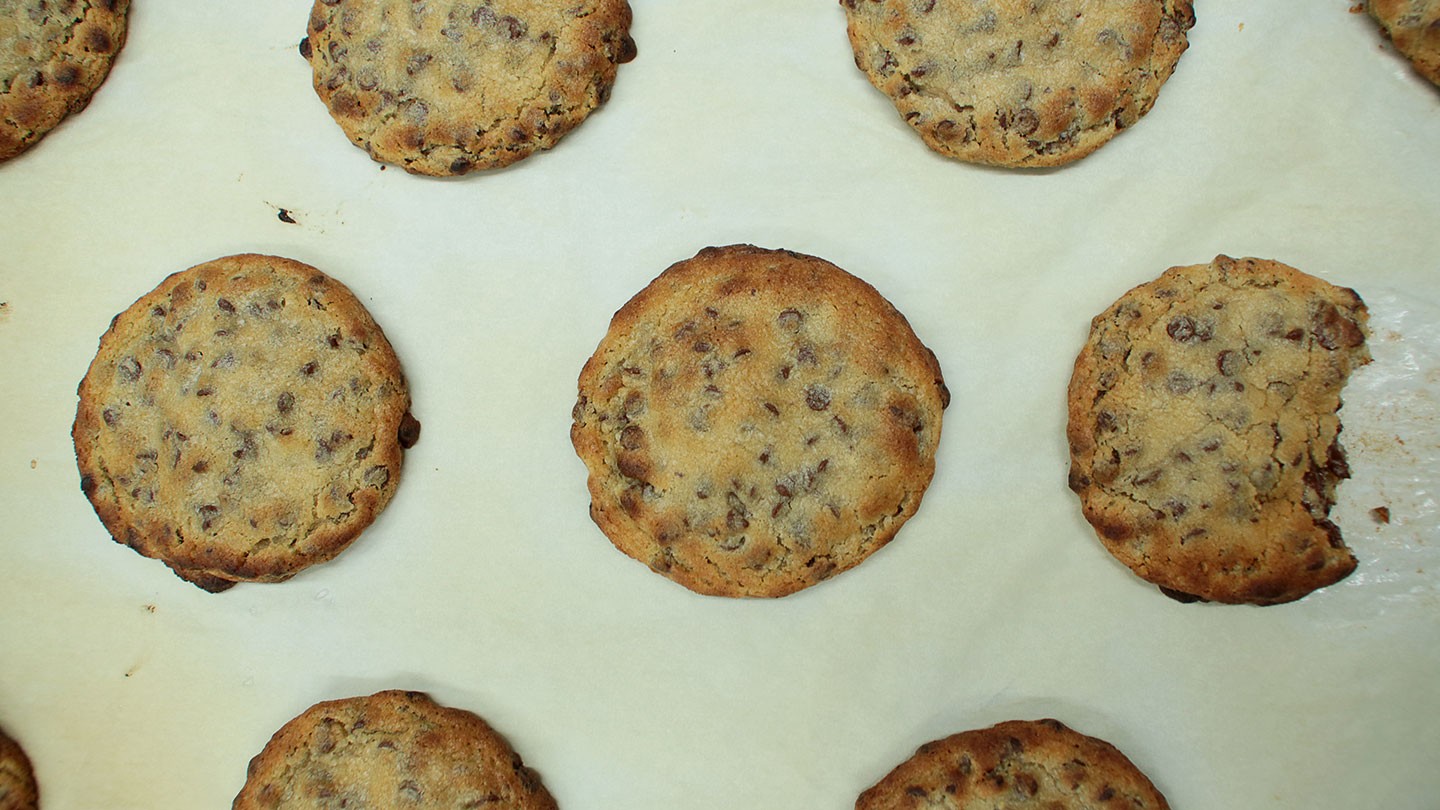Photo via Flickr user elkie456
Much like its halves, the black and white cookie’s history is often split: It’s been associated with racial harmony thanks to an episode of Seinfeld in the 90s and even President Obama used it as a metaphor for race relations during his 2008 run for president, calling them “Unity Cookies.” Then three years ago, a black Orthodox Jewish writer, rabbi and author wrote that black and white cookies have no business having this moniker, and their German origins and association with Jewish culture are murky at best.But all of this back and forth is a smoke screen for the true origins of the black and white cookie, which can actually be traced to good old fashioned commercialism. At the end of the 19th century, bakeries were likely looking to cash in on the latest dessert fad: Matching dark and light elements in one dessert, like chocolate frosting layers in a vanilla cake. It’s around this time that soft, large, cake-like cookies were also beginning to appear, including the black and white.“The cookie was keying into a popular kind of cookie at that time,” Stephen Schmidt, member of the Experts Bureau of the Culinary Historians of New York (CHNY) who also runs a food database called Manuscript Cookbooks Survey, told MUNCHIES. “The black and white thing: That was a very popular conceit right around that time. There were all kinds of cakes that had dark and light layers, cakes with red and light layers and even red, light, and dark layers. It was something people were doing with cake, so it’s not at all surprising someone thought to transfer this to the icing of a cookie. It was very much of a piece with the times.”Until this time in history, cookies were thin and crisp, not big, fat dropcakes. It was a new idea at the turn of the century to have this cake-like cookie with chocolate fondant on one side and vanilla fondant on the other. In the early 20th century, the cookie first reportedly appeared in Utica, New York at Hemstrought’s Bakery and were called “half moons.” Back and forth about its German origins and then embrace by New York City and Jewish culture still happens, but Schmidt is not necessarily buying this well-worn origin story.

“It all sounds like fake-lore to me; I have a feeling the black and white cookie was a commercial invention, capitalized on things that were in the air,” says Schmidt, pointing to trends in period interiors where contrasts in color could be found in tiles, wood floors, ceiling coiffers and even ceramics. “People like to think these things [the creation of black and white cookies] came from some kind of a culture, but very often that things that happen within the last 100 or so years tend to be commercial inventions.”Lust for cake as cookies was also a part of Southern culture, food writer Kathleen Purvis notes. Called tea cakes, people relied on these recipes to make a sturdy, long-lasting cookie when people dropped by to visit. “They were a very simple cookie that didn’t take long to make because a lot of times in the South, running your oven in the middle of the day was not something you wanted to do,” Purvis told MUNCHIES. “People can up with things that were quick and easy to bake and would also keep a long time in our humidity.”Schmidt further credits the black and white cookie explosion to its relative cheapness to make, and (as I would learn) its quick 10-minute frosting turnaround time. I desperately tried to get a black and white cookie lesson under my belt at Rocco’s Pasticceria, a famous Italian-American bakery located at Bleecker and Leroy Street with a second location in Brooklyn. Alas, I was late to the party: By the time I called to say I was on my way, the cookies were half frosted. Once I got to the bakery itself, though I’d been running like I was being chased, they were completely done.
Advertisement
Advertisement

“It all sounds like fake-lore to me; I have a feeling the black and white cookie was a commercial invention, capitalized on things that were in the air,” says Schmidt, pointing to trends in period interiors where contrasts in color could be found in tiles, wood floors, ceiling coiffers and even ceramics. “People like to think these things [the creation of black and white cookies] came from some kind of a culture, but very often that things that happen within the last 100 or so years tend to be commercial inventions.”Lust for cake as cookies was also a part of Southern culture, food writer Kathleen Purvis notes. Called tea cakes, people relied on these recipes to make a sturdy, long-lasting cookie when people dropped by to visit. “They were a very simple cookie that didn’t take long to make because a lot of times in the South, running your oven in the middle of the day was not something you wanted to do,” Purvis told MUNCHIES. “People can up with things that were quick and easy to bake and would also keep a long time in our humidity.”Schmidt further credits the black and white cookie explosion to its relative cheapness to make, and (as I would learn) its quick 10-minute frosting turnaround time. I desperately tried to get a black and white cookie lesson under my belt at Rocco’s Pasticceria, a famous Italian-American bakery located at Bleecker and Leroy Street with a second location in Brooklyn. Alas, I was late to the party: By the time I called to say I was on my way, the cookies were half frosted. Once I got to the bakery itself, though I’d been running like I was being chased, they were completely done.
Advertisement
Rocco Generoso Jr., Rocco Sr’s son, says Italian-Americans living in the West Village in the 1950s were making oversized black and whites, and credits the cookie to Italian-American culture. His secret to their perfect black and whites: A layer of apricot jam that lays under the chocolate and vanilla fondant, adding a warm, subtle fruit flavor along with the zest of orange flavor and almond-flavored butter baked into the cookie itself. “Italian bakeries make them and every bakery makes it different, put a little bit of apricot on it, some places don’t,” he says.This variety-is-the-spice-of-black-and-whites can be found all across New York City. Glaser’s Bake Shop on 87th Street and 1st Ave has been serving their famous black and whites with a fluffy layer of frosting and plain cake for more than 116 years (and will shut its doors on July 1, 2018 after three generations of bakers). That’s almost as old as the first half moons made in Upstate New York. Kosher Jewish bakeries like Moishe’s Bake Shop in the East Village make non-Rocco-sized black and whites, hold the apricot. You can even find mini ones at Bagel Boss on the Upper East Side as a dessert to chase your bagel and lox.It may also seem easy to give in to the pre-wrapped, mass-produced black and whites at deli cash registers, but don’t: They’re a setup to a cloying, oversweet headache. Stick with the traditional bakeries that sell them in the windows, unwrapped (or at least freshly wrapped) at the cash register. Celebrate bakeries taking an opportunity over 100 years ago: Without their desire to hear the ding of their own cash register, we may not have had black and whites at all.“A fad is like an epidemic; the more people who are interested in it, the more people are interested in it,” says Schmidt. “It snowballs.”
